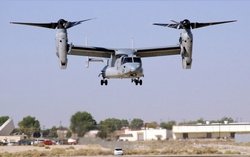...Yet Avoids It
The CV-22 test program reached a high point in its flight test
history when Osprey 7 successfully completed a terrain-following
radar exercise at Edwards AFB (CA), during its multimode radar test
plan segment.
 Osprey 9, expected to return to normal flight
testing in June, is undergoing hydraulic and electrical system
modifications and directed infrared countermeasures system
installation testing on its avionics, multimode radar and suite of
integrated radio frequency countermeasures.
Osprey 9, expected to return to normal flight
testing in June, is undergoing hydraulic and electrical system
modifications and directed infrared countermeasures system
installation testing on its avionics, multimode radar and suite of
integrated radio frequency countermeasures.
For Osprey 7, the terrain-following exercise test was a first in
its flight test history.
"We have to qualify this aircraft in all types of terrains,"
said Maj. Gregory Weber, CV-22 government flight test director.
"We'll also fly it in its three different flight modes of
helicopter, airplane and conversion mode, which is anything between
the helicopter and airplane mode."
When an aircraft does terrain following, the pilot programs a
desired height above the ground into the computer, and the computer
will guide the pilot to keep the aircraft above the ground at that
specific altitude.
"It's kind of like a cruise control that the pilot has to
manually work," said Weber. "The way it works is the computer has
the desired above-ground level to fly at. And when something like a
mountain comes up, it will tell the pilot to fly higher to stay at
the desired level. It also does the same if the plane flies above
the desired level."
As part of testing for Osprey 9, electronic warfare capabilities
and avionics testing are done to ensure the Osprey is fully
qualified for real-world missions.
"During the electronic warfare tests, they test the (suite of
integrated radio frequency countermeasures)," said Weber. "For the
avionics testing, they test the multimission advanced tactical
terminal and the multimode radar functions of the vehicle. The
reason we have to test this equipment is because we have mission
software that is unique to us at Edwards (and) in the Air
Force."
 The
Osprey is scheduled to be fully operational for Air Force Special
Operations Command in 2010.
The
Osprey is scheduled to be fully operational for Air Force Special
Operations Command in 2010.
"We are scheduled to be finished with testing in April of 2006,"
said Weber. "After we're done, it goes to the (Air Force
Operational Test and Evaluation Center at Kirtland Air Force Base,
NM,) for operational tests."
Currently, the Osprey is slated for other tests in April 2005.
"It's supposed to go through some 'envelope-expansion' testing,"
said Weber. "It's basically a wartime environment test of its
capabilities."
Capt. Gregg Leisman, a CV-22 flight test engineer, says the
CV-22 testing is going as planned. "With the program's past
history, I think it's going well," he said.
According to Lt. Col. J. D. Edwards, CV-22 operational test
director, the testing is meeting and exceeding expectations. "I
think we've made some big technical strides in testing this
aircraft,"
said Edwards. "The best reason for that is that we've taken the
time to find what problems there are on the aircraft and (are)
fixing them."
[Thanks to Airman 1st Class Matthew Dillier, Air Force Flight
Test Center Public Affairs --ed.]
 ANN's Daily Aero-Linx (04.17.24)
ANN's Daily Aero-Linx (04.17.24) ANN's Daily Aero-Term (04.17.24): Jamming
ANN's Daily Aero-Term (04.17.24): Jamming ANN's Daily Aero-Linx (04.18.24)
ANN's Daily Aero-Linx (04.18.24) Aero-News: Quote of the Day (04.18.24)
Aero-News: Quote of the Day (04.18.24) ANN's Daily Aero-Term (04.18.24): Hold-In-Lieu Of Procedure Turn
ANN's Daily Aero-Term (04.18.24): Hold-In-Lieu Of Procedure Turn




